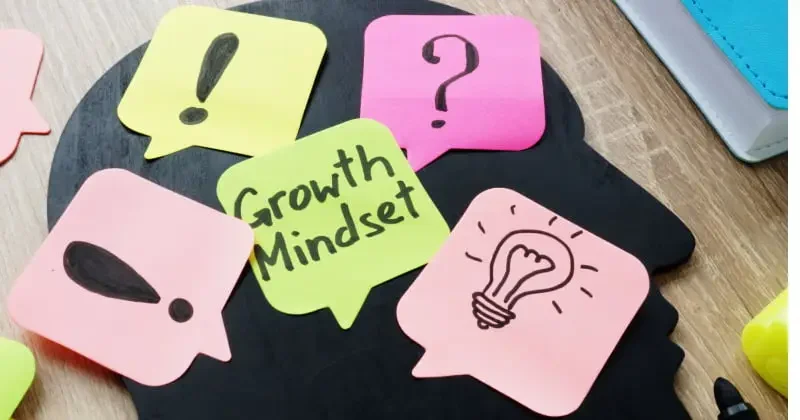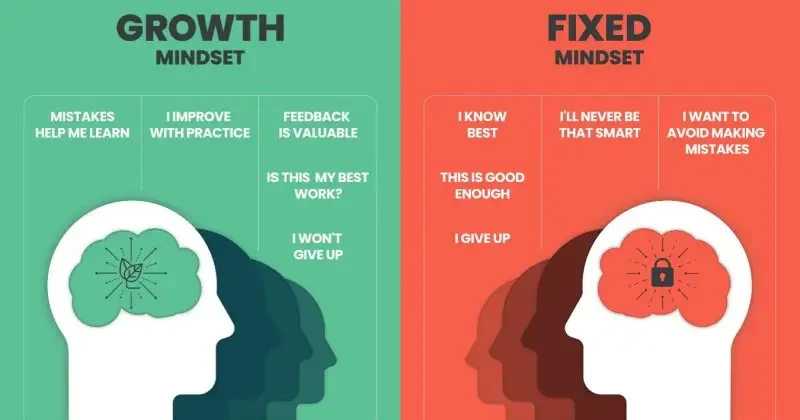Unlock Your Potential: How to Develop a Leadership Mindset
Written By Gavin Bryce

What is a leadership mindset and why is it important?
Successful leaders do more than just manage a team—it involves cultivating continuous learning, embracing change, and persistently aiming for success. Adopting a leadership mindset means you can transform not only your leadership but your business, too, bringing about remarkable improvements. In this blog, I will uncover the powerful leadership skills and traits of a growth-oriented leader, and the inherent advantages it brings to both individual and organisational success. So, whether you’re a seasoned leader or just starting out, adopting a growth mindset can be the game-changer you need.
“In a growth mindset, challenges are exciting rather than threatening. So rather than thinking, oh, I’m going to reveal my weaknesses, you say, wow, here’s a chance to grow.” – Carol S. Dweck
This blog outlines what a leadership mindset means and how to develop one. It is useful for those in leadership roles committed to leadership development. I will break down the fundamentals of the leadership mindset, from understanding its basis in self-awareness and resilience, how leadership transparency encourages openness, to exploring its influence in building empathy and challenging limiting beliefs. I provide practical strategies for infusing the leadership mindset culture into the very fabric of your organisation, as well as improving employee engagement.
What are the key characteristics of a leadership mindset?
If you wish to be an effective leader, adopting a growth mindset is an important leadership skill to hone. This starts by recognising the critical elements that comprise a leadership mindset. Let’s delve two crucial traits and qualities for leadership roles.
Flexibility is a fundamental trait for effective leadership. It involves the willingness and ability to adapt to changing situations. Leaders with a growth mindset understand that maintaining a rigid stance won’t serve their long-term objectives. They are always open to learning, enabling them to adjust their approach when necessary.
Another crucial leadership quality is courage. Having the fortitude to take calculated risks and make tough decisions forms a core part of a leader’s role. A leader with a growth mindset is not averse to venturing into the unknown if it aligns with their end goals. They understand that failure is part and parcel of the growth process.
How does having a leadership mindset contribute to business success?
You already know that change is an inevitable part of business success. This is ever more apparent given our uncertain world currently, rife with economic challenges and geopolitical unrest. How you handle change is where a growth mindset comes in. By embracing a growth mindset, you’re not just responding to change, you’re harnessing it as a tool for growth and pushing you and your company forward. Let’s delve deeper into understanding how this right mindset can drive business success.
So, what exactly is a growth mindset? First coined by psychologist Carol Dweck, a growth mindset is defined as the belief that leadership abilities and intelligence can be developed through dedication, hard work, and the right type of encouragement. It’s the opposite of a fixed mindset where people believe their leadership abilities are static and unchangeable. Individuals with a growth mindset are more resilient, willing to take calculated risks, and constantly learning from their experiences.

Which is the right mindset?
| Growth Mindset | Fixed Mindset | |
|---|---|---|
| Attitude Toward Challenges | Embraces challenges as opportunities for learning and development. | Avoids challenges as they are seen as threats. |
| Response to Failures | Considers failure as a stepping stone towards improvement and success, learning from the experience. | Fear of failure restricts effort and initiative, considering it a negative reflection of their abilities. |
| Approach to Effort | Views effort as fruitless, proving that they’re not naturally talented or smart. | Views effort as fruitless, proving that they’re not naturally talented or smart. |
| Attitude Towards Criticism | Values and learns from criticism, sees it as a way to identify areas for development. | Tends to ignore useful feedback and criticism, often feeling threatened by it. |
| View on the Success of Others | Is inspired by the success of others, uses it as motivation to improve and thrive. | Feels threatened by the success of others, often resorting to negative comparisons. |
But, how does this relate to leading a business?
Imagine this scenario. Your business is facing severe challenges, and you have two options: maintain the status quo and hope things improve or recognise the need for change and actively seek ways to innovate and improve. Which seems more promising? Spoiler alert – it’s the latter!
The function of leadership is to produce more leaders, not more followers.
– Ralph Nader
Cultivating a growth mindset involves your whole business – it’s not just about individual success. It’s about inspiring everyone around you and your leadership team to also adopt this mindset. It’s about fostering a culture of continuous learning and improvement that promotes employee engagement. In this way, leadership transparency encourages openness throughout the organisation.
So, how can you make the shift to a growth mindset if you find yourself more aligned with a closed mindset? Here are a few strategies:
- Embrace Challenges: Instead of shying away from them, view challenges as providing opportunities for growth. Recognise that failure is not the end, but part of the process.
- Prioritise Learning: Look for opportunities to learn something new every day. Be a humble leader that acknowledges you don’t know it all. Encourage your leadership team to do the same. Help your team by promoting a culture of continuous improvement.
- Join a Peer Group: Consider joining a leadership peer support group, like Vistage. Peer groups help to push you out of your comfort zone and can help you make better decisions.
- Keep an Open Mind: Be open to feedback and different perspectives. Use it as an opportunity to learn and improve.
- Get a Leadership Coach: A leadership coach can help challenge you to cultivate a growth mindset helping you to keep moving forward.
- Practice Patience: Remember, change takes time. Be patient, but persistent in your drive to develop a growth mindset.
The adoption of a growth mindset can be the springboard to incredible business success and greater employee engagement. Rather than fearing change and challenges, embrace them as chances to learn and grow as a humble leader. Remember, everyone can develop a growth mindset with consistent practice and effort. It’s a matter of choosing to see opportunity in every challenge, to continuously learn and improve, and engage everyone in your leadership team in this journey of forward-thinking and improvement. If you need more convincing, check out some of the articles below supporting the importance of growth mindsets in leadership.
Data Supporting the Importance of a Growth Mindset in Leadership
Developing Self-Awareness: The Foundation of Effective Leadership

Every great leader begins their journey inward. That’s right. You, as a leader, must delve into your inner self to develop an understanding of your strengths, weaknesses, biases, and behavioural tendencies. We know this introspection journey as self-awareness, which could make all the difference to your effective leadership.
Without increased self-consciousness, you can easily fall into idealised visions of leadership, ignoring actual growth areas and feedback. Remember, leadership by its very nature is about inspiring and guiding others. Leaders are effective when they have a genuine desire to grow and evolve.
- Understanding Your Strengths: By recognising your areas of strength, you can better leverage these abilities to influence and lead others. Knowing where your expertise lies allows you to build a team focused on achieving your vision and that complements your skills, resulting in a more productive workforce.
- Acknowledging Your Weaknesses: Embracing your weaknesses isn’t about brewing self-doubt; rather, it’s about self-improvement. For example, do you shy away from tough conversations? With humility and honesty, accept what you lack and seek ways to improve or complement these areas through training, mentorship, or collaborative team-building.
- Confronting Biases: Consciously or unconsciously, biases may creep into your decisions. Being aware of these biases helps in cultivating a fair and less biased working environment–a crucial step towards fostering diverse and inclusive teams focused on success.
- Understanding Behavioural Tendencies: By identifying traits like reactivity, avoidance, or procrastination you can strategically mitigate their impact on your leadership.
Developing higher degrees of self-consciousness doesn’t occur overnight. It’s a journey of continuous learning and self-examination. It’s about discovering your blind spots and seeking feedback from others. Above all, it’s about embracing a growth mindset that thrives on challenges, stimulates learning, and inspires development in oneself and others around you.
Remember: “The first step towards change is awareness. The second step is acceptance.” – Nathaniel Branden
In the end, self-awareness outlines your roadmap, honing your approach towards effective leadership. It determines how well you can navigate the intricacies of your thoughts, feelings, and behaviours, to centre those around growth and success.
Challenging Limiting Beliefs: Overcoming Obstacles to Leadership Growth

What’s holding most great leaders back isn’t a lack of potential or skill. Often, the obstacles emerge from within the leaders themselves — as limiting beliefs. These silently influential thoughts can have a profound impact on motivation, performance, and the capability to instigate change.
Tackling such beliefs isn’t a simple task, but it’s an essential step to achieving leadership growth. It’s a journey that starts with recognising what your limiting beliefs are, then challenging them, understanding their origin, and finally, reformulating them into empowering beliefs.
Recognising Limiting Beliefs
For many leaders, their limiting beliefs hide in plain sight, subtly influencing their attitudes and behaviours. Such beliefs might include thoughts like “I can’t lead because I’m not confident enough” or “I’m not good at problem-solving”. These are groundless beliefs which, when left unchecked, could stifle your growth potential.
Challenging Limiting Beliefs
To challenge your limiting beliefs, you need to question them critically. Ask yourself: Is this belief really true? Where’s the evidence that I can’t lead or solve problems? Is there a more empowering way I could view this situation? Doing so will help you realise these beliefs are often subjective narratives, not objective truths. I call this conscious leadership because limiting beliefs are born in the unconscious mind. No leader would consciously choose to feel like a failure, or that they are a fraud. Hence, when we think and feel this way, it is unconscious and unhelpful.
Understand the Origin of Your Beliefs
All beliefs, including the limiting ones, originate from somewhere. Even the best leader has self-doubt. It could be a past failure, criticism, or even societal expectations. Understanding the origin can help you recognise the potential mind traps and, subsequently, help you avoid falling into them. It’s the first step to sanity-checking your thought processes and thereby promoting healthier thinking to build confidence.
Reformulating Limiting Beliefs Into Empowering Ones
Once you’ve debunked your limiting beliefs, it’s time to turn them into beliefs that empower you. Instead of thinking, “I can’t lead because I’m not confident enough, ” switch it to, “I’m a confidence leader and I am growing every day”. Ultimately, the goal is to promote positive thinking that reinforces self-confidence.
Challenging and overcoming limiting beliefs is a continual process that bolsters leadership growth. It requires persistent introspection and the courage to question one’s own thought processes. But, with patience and determination, you can dissolve the barriers that impede your progress, making way for a stronger, more effective leadership approach.
How can I measure my progress in developing a leadership mindset?
Measuring progress towards adopting a growth mindset in leadership might seem challenging, but it can certainly be done. The shift from a fixed to a growth mindset is gradual and often subtle, meaning it’s important to evaluate yourself regularly. This self-evaluation is an essential part of promoting meaningful change and recognising how far you’ve come. But how can you measure this change?
- Reflection and Self-Assessment: An important initial measure is through regular self-assessment and reflection. Evaluate your reactions, decisions, and actions constantly. Try to recognise when you’re showing traits of a growth mindset and when you’re falling back into old, fixed mindset patterns. Remember, being self aware is key.
- Feedback from Others: Another effective measure is through feedback from your peers, a leadership coach, colleagues or direct reports. External viewpoints provide a different perspective and can shed light on areas you might not be aware of. Remember to be open to feedback, both positive and negative.
- Setting and Attaining Goals: Setting clear, measurable goals for your development as a leader is another crucial measure. A leadership coach can support you with this. By setting goals related to your growth mindset, you make the concept more tangible and trackable. Attaining these goals can be a clear sign of progress.
Be aware that developing a growth mindset involves more effort that just box ticking. It’s a continuous process that requires sustained commitment and dedication.
Reflecting on your Emotional Intelligence
Emotional intelligence (EQ) is a powerful tool in the arsenal of a leader with a growth mindset. It’s about understanding your emotions, managing them positively, and empathising with the emotions of others. Think about your recent encounters in your leadership role. Have you listened actively and shown empathy? Have you managed conflicts effectively and shown resilience in the face of setbacks or failures? Reflecting on how you have applied EQ in your everyday behaviour can be an excellent indicator of your progress in developing a leadership mindset.
Looking for Evidence of Personal Growth
Seek evidence of personal growth. Are you embracing challenges with more eagerness? Are you showing resilience in the face of setbacks and failure? Are you demonstrating more flexibility and adaptability? Look at how you’ve handled previous challenges compared to now. This can provide a pointer to how you’ve developed.
Monitoring Change in Your Environment
The effects of adopting a growth mindset in leadership are often visible in the surrounding environment. Look for signs of a positive change in team dynamics, communication, and overall productivity levels. Are your colleagues more receptive to your leadership style? Do you openly praise individual’s efforts, more often? Is the overall morale and satisfaction levels of your team increasing? Has your decision-making improved? Such measurable changes in your working environment can be powerful indicators of your advancement as a leader.
This continual self-assessment will not only reflect your growth, but will also equip you to guide your team better. Embrace the journey of growth with patience, persistence and positivity!
Key Messages in this Leadership Blog
- A leadership mindset means being agile, adaptable, and open to learning and improvement.
- Successful leaders possess a growth mindset characterised by the belief that abilities can be developed through dedication and hard work.
- The adoption of a leadership mindset contributes significantly to business success, fostering innovation, resilience, and positive work culture. An indicator of success may include noticing that you praise individual’s efforts more often, a more cohesive team and increases in employee’s happiness.
- Leadership growth often involves a significant change from a closed mindset, which views abilities as static, to a growth mindset that views abilities as malleable.
- Evidence supports the importance of a growth mindset in leadership, showing greater goal attainment, increased effort, and higher achievement.
- Being self-aware is pivotal in effective leadership, as it facilitates understanding of one’s strengths, weaknesses, beliefs, and values.
- Challenging and reformulating limiting beliefs is at the heart of leadership growth, enabling the breakdown of unconscious mental barriers.
- Recognising, understanding, and challenging the origin of one’s beliefs forms an essential part of the leadership growth process.
- We can measure progress in developing a leadership mindset through reflection on EQ, tracking personal growth evidence, and monitoring environmental changes.
Frequently Asked Questions (FAQs)
What are the key characteristics of a leadership mindset?
A leadership mindset is characterised by elements such as forward thinking, the ability to inspire others, a focus on solutions rather than problems, and the capacity to take decisive actions even under adverse conditions. A leader’s mindset is continually seeking growth, developing self-awareness, and challenging limiting beliefs. It also thrives on feedback, practicing humility, and developing resilience. More than a set of skills, it’s a holistic way of thinking and acting in the world. This mindset explores opportunities for innovation and values collaboration and inclusivity. Ultimately, a leadership mindset embodies the vision, courage, and integrity to drive meaningful changes in both oneself and others.
How can I develop a leadership mindset?
Developing a leadership mindset is not a one-off event. It demands constant self-analysis, learning, and growth. Begin by establishing a strong self-understanding. Recognise your strengths, weaknesses, and core values. This self-identification process fosters an authentic leadership style which resonates with your team. Next, cultivate a growth mentality. Embrace failures as opportunities to learn and grow, rather than setbacks. Equally essential is the ability to manage your emotions, leading with empathy and understanding others’ perspectives. The practice of mindfulness is a practical tool in this. Actively challenge any limiting beliefs that may constrain your potential. Turn them around into empowering beliefs that stimulate optimistic behaviors and actions. Don’t forget the power of lifelong learning. Keep refining your skills, acquire new ones, and stay abreast of the latest in leadership practices by reading blogs like this one. Being part of a peer group, leadership coaching and mentorship can also play a crucial role in the development of your leadership mindset. Finding an excellent coach will provide you access to advice from an experienced leader, further speeding up your growth. Get in touch if you’d like to understand more about how coaching could support your leadership journey.
What are some practical strategies for developing a leadership mindset?
Developing a leadership mindset takes intentional effort and practice. To start, expose yourself to leadership material, such as books, podcasts, and videos from respected leaders in your field. Understand the importance of emotional intelligence and work on enhancing this within you. Get clear on your core values, and make decisions that align with them. Practice effective communication – both speaking and listening. Another practical strategy is to foster resilience. You can be achieve this by learning from your failures and viewing challenges as opportunities. Embrace the notion of a growth mindset, where potential is unlimited and intelligence and talent are just the starting points. By continually learning, embracing challenges, persisting in the face of setbacks, treating effort as a path to mastery, and learning from criticism, you can cultivate a leadership mindset.
What role does self-awareness play in developing a leadership mindset?
The role of self-awareness in developing a leadership mindset is absolutely critical. As a leader, you must first understand yourself and your unique strengths, weaknesses, and emotions so that you can effectively guide and influence others. Only when you fully comprehend your own motivations and behaviours, can you expect how others might react to your leadership style. Self-awareness allows you to maintain an objective view of your performance and actions, helping you to recognise and address any potential shortfalls promptly. Thus, we cannot overstate the integral role of self-awareness in cultivating a leadership mindset. It is the cornerstone upon which we build the other elements of a leadership mindset, such as emotional intelligence, decision-making skills, resilience, and adaptability.